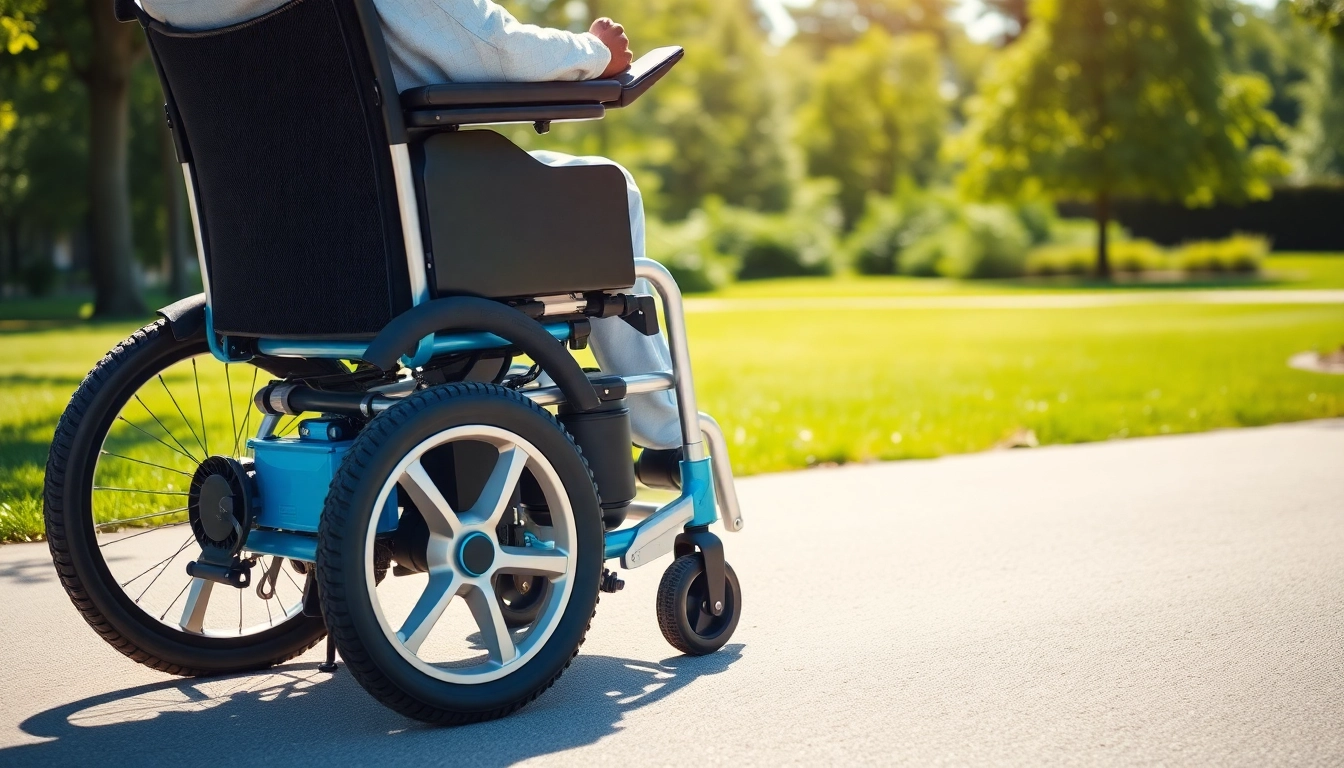Understanding Power Wheelchairs
What is a Power Wheelchair?
A power wheelchair is an electric wheelchair powered by batteries, designed to assist individuals with mobility limitations. Unlike manual wheelchairs that require physical effort to propel, power wheelchairs offer greater autonomy through motorized functions. Equipped with joystick controls, these devices allow users to navigate smoothly and easily in various environments, from homes to public spaces. They come in several designs tailored to meet diverse needs, whether it be for indoor use, outdoor excursions, or specific medical conditions.
Differentiating Power Wheelchairs from Manual Options
Power wheelchairs are distinct from manual wheelchairs in key aspects. The primary difference lies in propulsion: while manual wheelchairs necessitate human power, typically through arm strength, power wheelchairs rely on electric motors. This fundamental difference influences various factors including:
- User Independence: Power wheelchairs offer enhanced independence for individuals with limited upper body strength, enabling them to navigate without the assistance of a caregiver.
- Range of Motion: Power wheelchairs often allow users to cover greater distances more quickly and with less physical exertion.
- Versatility: Many power wheelchairs come with advanced features such as reclining backrests, leg rests, and programmable controls that adjust to meet the user’s specific needs.
Key Features of Modern Power Wheelchairs
Modern power wheelchairs are laden with innovative features designed to enhance user experience and satisfaction. Here are the hallmarks of contemporary models:
- Adjustable Seating: Customization options allow users to alter seat height, width, and depth for optimal comfort.
- Advanced Control Systems: Joystick controls are now accompanied by alternative methods like head controls and sip-and-puff systems, catering to varying degrees of mobility.
- Durable and Lightweight Materials: Manufacturers are now utilizing high-strength aluminum and carbon fiber composites to create modern power wheelchairs that are robust yet lightweight.
- Enhanced Battery Life: Advanced battery technologies allow for longer usage between charges, ensuring users can go about their day without frequent recharging.
- Terrain Handling Capabilities: Many models are designed to handle different terrains, making them suitable for both indoor maneuvers and outdoor adventures.
Benefits of Using a Power Wheelchair
Improved Mobility and Independence
One of the most significant advantages of power wheelchairs is the enhanced mobility they provide. Individuals who may struggle with manual wheelchairs due to physical limitations can achieve a level of independence that was previously unattainable. For instance, users can participate in social activities, complete errands, or simply explore their surroundings without relying heavily on assistance. The freedom to navigate environments easily can vastly improve quality of life.
Customization Options for Individual Needs
Power wheelchairs can be tailored to fit the unique needs of each user. Healthcare professionals often work with users to determine specific requirements, be it adapting seat configurations or mastering control systems. Many brands offer customizable options that cater to specific medical conditions, ensuring that each user finds the right fit for their lifestyle and health circumstances.
Enhanced Comfort and Safety Features
Safety and comfort are paramount in the design of modern power wheelchairs. With options for seat cushions, lumbar support, and stability features, users can navigate their environments without fear of discomfort or injury. Additionally, many models include safety features like seat belts, anti-tip mechanisms, and headlights, ensuring that users can move confidently in various conditions, including low-light situations.
Choosing the Right Power Wheelchair
Factors to Consider Before Purchase
Purchasing a power wheelchair is a significant decision that requires careful consideration. Here are key factors to keep in mind:
- User Mobility Needs: Assessing the individual’s mobility requirements is crucial. Factors like the range of travel, terrain type, and indoor versus outdoor use can dictate the kind of power wheelchair suitable for the user.
- Weight Capacity: Ensure the power wheelchair can support the user’s weight. Every model has a specified weight capacity that should not be exceeded to prevent malfunctions or safety hazards.
- Customization Options: Consider how adjustable a wheelchair is to cater to specific health conditions. Customizable seating and control options can significantly enhance user comfort.
- Session Length: Evaluate how long the user will typically be in the wheelchair. Longer sessions may require more ergonomic features and durability from the materials.
- Cost and Insurance Coverage: Power wheelchairs can vary widely in price. Investigate what your insurance will cover and explore financing options where necessary.
Top Brands and Models Reviewed
When it comes to reliable power wheelchair brands, several stand out for their innovation and user satisfaction. Some notable brands include:
- Permobil: Renowned for their customization and advanced technology, Permobil models offer a range of features and configurations suitable for diverse users.
- Golden Technologies: Their power wheelchairs provide excellent maneuverability, comfort, and affordability, making them a popular choice for users.
- Invacare: Known for durable designs and good service options, Invacare power wheelchairs cater to various user needs.
- Pride Mobility: With a focus on user comfort and ease, their models feature advanced control systems and are designed for both indoor and outdoor usage.
Assessing Your Health and Mobility Needs
Before deciding on a power wheelchair, it’s essential to assess both health requirements and mobility needs comprehensively. Consulting with healthcare professionals, especially occupational therapists, can provide critical insights into selecting the right model. Users should analyze aspects such as the wheelchair’s function in day-to-day activities, compatibility with home and vehicle accessibility, and whether its features will support long-term health needs.
Maintenance Tips for Power Wheelchairs
Regular Checks for Optimal Performance
To ensure a power wheelchair remains in optimal working condition, regular maintenance checks are essential. Users should adhere to the following practices:
- Weekly Inspections: Check tire pressure, battery life, and the condition of various moving parts like wheels and footrests.
- Clean Components: Regularly clean the chair’s parts to prevent dust accumulation, which can cause wear and tear over time.
- Professional Servicing: Schedule annual check-ups with a professional technician who can identify and resolve issues that may not be visible to the user.
Battery Care and Replacement Guidelines
The battery is the heart of a power wheelchair; ensuring its longevity is critical for performance. Adhere to these guidelines for optimal battery care:
- Charging Routine: Charge the battery fully after each use, and do not allow it to deplete completely before recharging.
- Battery Storage: Store batteries in a cool, dry place when not in use to prolong their lifespan.
- Monitor Battery Health: Be attentive to any signs of decreased performance or range, as this often indicates it’s time for a battery replacement.
Signs That Your Power Wheelchair Needs Repair
Awareness of troubleshooting common issues can prevent more significant malfunctions. Here are some signs that indicate a power wheelchair may need repairs:
- Unusual Noises: Grinding, clicking, or popping sounds can signal mechanical issues requiring immediate attention.
- Battery Performance Loss: A noticeable reduction in range can indicate battery wear or malfunction.
- Unresponsive Controls: If the joystick or alternative control mechanisms do not respond as expected, it is crucial to assess for potential electronic faults.
- Physical Damage: Any visible signs of wear, cracks, or bends in the frame require prompt inspection and possible repair.
Success Stories: Power Wheelchairs in Action
Real-Life Testimonials from Power Wheelchair Users
The impact of power wheelchairs is profoundly illustrated through numerous testimonials from users around the world. For example, Jane, a long-time manual wheelchair user, shares how switching to a power wheelchair enabled her to navigate her community with ease. “I can now participate in family outings without needing help all the time. Going to the park became enjoyable instead of a chore,” she related. These stories not only highlight improved mobility but also underline increased self-esteem and engagement with life.
Community Programs Supporting Mobility
Numerous community programs focus on supporting individuals needing mobility assistance. These initiatives often provide power wheelchairs or financial assistance to eligible users. Organizations like the Power wheelchair distribution programs offer valuable resources to help those in need of mobility solutions become more active participants in their communities. Additionally, awareness campaigns create opportunities for social interaction and foster a supportive environment.
Future Innovations in Power Wheelchair Technology
Looking toward the future, breakthroughs in technology are expected to revolutionize power wheelchairs. Emerging trends include:
- Smart Technology Integration: Enhanced connectivity options using IoT can enable users to monitor their wheelchair’s metrics and receive maintenance alerts via smartphone applications.
- Artificial Intelligence: AI will ensure smarter navigation systems to enhance user safety by adapting to various environments and anticipating potential obstacles.
- Wearable Technology Compatibility: Integrating wearables with power wheelchairs to enhance health monitoring could lead to a more personalized mobility experience.



